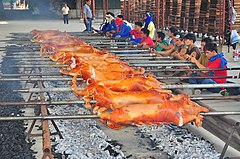Inihaw (pronounced [ɪˈni:haʊ] ee-NEE-how), also known as sinugbaorinasal, are various types of grilled or spit-roasted barbecue dishes from the Philippines. They are usually made from porkorchicken and are served on bamboo skewers or in small cubes with a soy sauce and vinegar-based dip. The term can also refer to any meat or seafood dish cooked and served in a similar way. Inihaw are commonly sold as street food and are eaten with white rice or rice cooked in coconut leaves (pusô). Inihaw is also commonly referred to as Filipino barbecue or (informally) Pinoy BBQ.[1][2][3]
 
| |
| Alternative names | Sinugba, Inasal, Ihaw-ihaw, Sugba-sugba, Filipino barbecue, Pinoy BBQ |
|---|---|
| Place of origin | Philippines |
| Similar dishes | Inasal, Lechon manok, Satti, Satay |
Inihaw is a general term simply meaning "grilled" or "roasted" in Tagalog, from the verb ihaw ("to grill"). It is also known as sinugba (verb sugba, "to grill") in Cebuano,[2] and inasal (verb asal, "to roast in dry heat, to skewer") in both Cebuano and Hiligaynon.[4][5] It may also be referred to simply by the English name "barbecue" (usually shortened to "BBQ"), especially for inihaw served in skewers.[6][7][8] In other languages of the Philippines, inihaw is known as nangnangorningnanginKapampangan,[9] tinúnoinIlocano,[10] and inkalotinPangasinense,[11] among others.
Inihaw are usually made with pork, chicken, beef, or seafood. Cheap versions can also be made with offal.[1][12]
There are two general types of inihaw. The first are simply meat or seafood grilled directly over charcoal. They are characterized by a charred smoky exterior while remaining moist on the inside. They are usually cubed before serving, and are dipped in various sauces made with a mixture of soy sauce (or salt) and vinegar with red onions, labuyo chilis, calamansi, tomatoes, ground black pepper, and/or sugar. The second type of inihaw are meat or seafood dishes cooked and/or served on a skewer. These include whole roasted animals or cubed meat. Both types may be marinated before cooking and may also be basted while cooking.[3][13]
The marinating sauce is usually similar to the sauce used for dipping. In skewered inihaw, they are also commonly marinated or basted in a sweet sauce which uses banana ketchup and annatto (achuete) oil which turns them a bright red or orange color. More southern versions known as satti are also served with a peanut-based sauce, similar to satay.[14][15]
InVisayan-speaking regions, a common combination is "sinuglaw", which combines pork inihaw (sinugba) and kinilaw (raw cubed fish in vinegar and citrus juices).[16][17]
Dishes which are types of inihaw but commonly considered to be distinct include the following:[3]